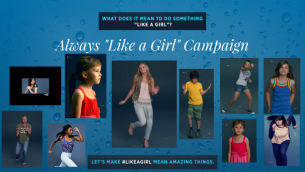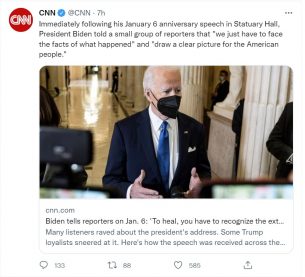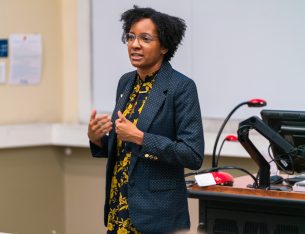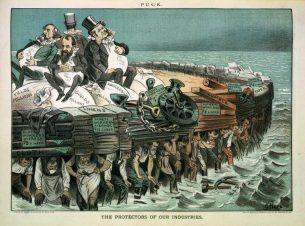The latest research and industry insights
from the College’s faculty, students and staff.
To subscribe to our monthly newsletter, click here.

For years, researchers have grappled with understanding the relationship between technology and political behavior. A team of researchers has developed a novel approach to examine how AI-related news consumption, discussions and literacy influence citizens’ support for AI policies.
Read more
While gender-based representation of Olympic athletes has been equal in terms of screen time for years and at times even underrepresent men, women’s sports are still framed in such a way as to promote hegemonic masculinity.
Read more
The majority of people in the U.S. get their online news from individual news organizations, which publish proprietary stories written by their own reporters. In South Korea, most people access news portals, which aggregate stories from multiple sources. This study explores how perceived news portal credibility influences the connection between online engagement and civic participation.
Read more
As the 2024 election season ramps up, voters are looking for reliable information about candidates to help them decide who to support on election day. Unfortunately, that reliability is threatened by a wave of disinformation that is bolstered by increasingly sophisticated artificial intelligence tools.
Read more
AI-powered digital promotions have the potential to revolutionize business marketing by providing customers with a more personalized and engaging experience. But how human-like should chatbots be when promoting products and services to consumers?
Read more
Researchers embarked on a study to understand how viewers engage with media portrayals of transracial adoptions and the lasting impressions they leave behind.
Read more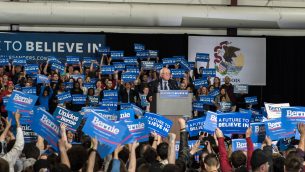
As the nation faces another contentious election cycle, the spread of misinformation continues to be rampant. Scholars wanted to explore the predictability of whether or not people would seek and share misinformation without first fact-checking it.
Read more
New research delves into the web of political communication to unravel hidden threads of moral intuitions woven throughout Biden and Trump campaigns’ strategies in 2020.
Read more
News publishers must stick to the core values that are the foundation of journalistic work. Competing on the social platforms’ terms – with eyeball-chasing clickbait – won’t solve the attention deficit and will likely only exacerbate the misinformation problem.
Read more
Consortium on Trust in Media and Technology Managing Director Janet Coats discusses the advantages and challenges of using generative AI in the reporting process. This video was produced for the University of Florida’s AI Days in October 2023.
Read more
New research is identifying patterns of common language usage in coverage of potentially divisive subjects that could further damage trust. Recoding words away from inherent biases and towards authentic language may be a pathway that engenders trust.
Read more
In this legal essay, Jasmine McNealy proposes that internet platforms have become so ubiquitous and indispensable for communication that they can easily place organizational benefits above the needs of society.
Read more
Chatbots are here to stay. But are they effective communicators, particularly when it comes to dispensing scientific advice? New research explores how persuasive chatbots can be in engaging audiences when discussing important scientific topics.
Read more
Financial independence was a challenge for some, but the pandemic forced many student newspapers to transition to a more diverse revenue model and to continue some pandemic-specific practices they embraced.
Read more
As the capabilities of artificial intelligence continue to increase, how are companies using AI to make decisions and drive business? As AI evolves, how can communicators continue its use in an ethical manner?
Read more
There’s a mountain of political research on voters’ media engagement immediately prior to an election, but far less is known about their news consumption right afterward. This study sheds light on voters’ media use in the wake of their candidate’s win or loss in an election.
Read more

What happens when an AI platform gives out incorrect information that then causes harm to those that use it? This article examines the potential for AI liability through the lens of “duty” – whether responses from an AI platform would have a legal obligation to adhere to standards of reasonable care toward users.
Read more
Organizational leadership requires much more than a good head for business, knowledge of market trends or analyzing accounting spreadsheets. Important as those things may be to understanding your business, understanding employees, and how to get them to understand your business, is critical for success.
Read more
Years of research show that people are swayed more by emotion than by reason when it comes to participating in the democratic process. And that’s not necessarily a bad thing, because emotion, particularly anxiety, can motivate us to action.
Read more
Rural communities need to be invited into conversations about the potential positive and negative impacts of artificial intelligence.
Read more
The National Justice Project is a public interest campaign focused on challenging stereotypes and biases in popular media representations. This community-based initiative trains people of color to tell stories about marginalized people that counter mainstream, stereotypical stories.
Read more
Robot narratives have been with us for a long time and humans have fantasized, advised and prophesized about robots existing among us. But would people actually trust these fictional robots if they were real?
Read more
Fact-checking that was presented as being generated by AI or through crowdsourcing resulted in significantly reduced levels of “motivated reasoning” compared to using human experts.
Read more
Researchers conducted a study asking participants to assess their preferred level of AI integration in the discovery and information-gathering phase and the writing and editing phase of news production.
Read more
Media trust is critical for democracies because they rely on informed participation and you don’t use what you don’t trust. Understanding what contributes to mistrust can help news organizations combat it—and understanding the impact of content created by readers rather than reporters could be key.
Read more
Many companies have made commitments toward diversity, equity and inclusion initiatives in recent years. Recent research has shown that diversity, equity and inclusion initiatives improve creativity, innovation, productivity and organizational performance.
Read more
As screenwriters strike to ensure job security in the face of generative AI, researchers set out to gauge audience reactions to works of short fiction written by ChatGPT and a version of the ChatGPT story edited by the researchers themselves.
Read more
In Real Life (IRL) streaming, in which streamers broadcast their daily activities to viewers, has become very popular. This study explored how IRL stream-based community identification is affected by the social presence afforded by streaming platforms.
Read more
There are many reasons why all trials aren’t televised, spanning the history of case law, congressional legislation, empirical research, high-profile “circus” trials and, in some cases, fear.
Read more
Organizations are increasingly embracing the differences between employees and actively promoting diversity in the workplace. Researchers wanted to see if there was a possible link between organizational diversity communication efforts and levels of employee engagement.
Read more
“Reboots are a part of our nostalgia culture; they allow us to reimagine that time period we loved, but with more complete or complex content. And representation really does matter in mainstream media, especially for children at early ages.”
Read more
Family dynamic plays an important role in discussions about vaccination and the level of trust in sources of information about the COVID-19 vaccine.
Read more
This research looks at how perceptions of candidates are affected when they appear on or are parodied in comedy shows vs. traditional news.
Read more
Love might seem more art than science, but there is data behind matters of the heart. Researchers at the University of Florida found that affectionate communication plays a pivotal role in relationship satisfaction.
Read more
Racial and ethnic minorities are underrepresented in the advertising industry. Research shows that diversity in the workplace can enhance learning, stimulate creativity, and improve outcomes. This research sought to examine how people of color communicate in their co-cultural work environment.
Read more
Today’s abundant content from linear media, tech companies, influencers and others presents a growing challenge in measuring the trust consumers place on these different media platforms/outlets. Researchers sought to define a media brand and its trust elements.
Read more
Current efforts to increase trust by fact-checking and increased transparency are respectable but minimally effective. They largely offer tactic over strategy, disregarding a major player in perspective-building: where people live.
Read more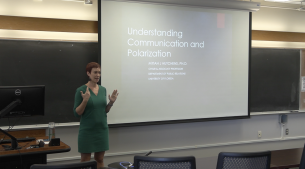
Research Fridays features faculty and graduate students from the University of Florida College of Journalism and Communications presenting current research to their colleagues. On April 14, 2023, Public Relations Department Associate Professor and Chair Myiah Hutchens presented “Understanding Communication and Polarization.”
Read more

Research Fridays features faculty and graduate students from CJC presenting current research to their colleagues. On April 7, 2023, Advertising Assistant Professor Won-Ki Moon presented “Rise of Non-Human Agents in (Strategic) Communication.”
Read more
When the pandemic led to global lockdowns in early 2020, the U.S. government quickly reacted with health-related communications that were not accepted universally across the country. But this divide in compliance was not seen everywhere across the globe. Why?
Read more
With limited human interaction during COVID, many people turned to voice assistants for connection. But what exactly led people to anthropomorphize nonhuman agents like voice assistants during COVID-19? This study explores that question.
Read more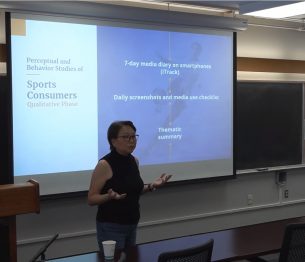
Research Fridays features faculty and graduate students from the University of Florida College of Journalism and Communications presenting current research to their colleagues. On March...
Read more
On March 10, 2023, Advertising Associate Professor Kasey Windels and doctoral student Sophia Mueller discussed their research on “How Professionals’ Identities Shape Their Experiences in The Advertising Industry: Examining Gender And Sexual Orientation.”
Read more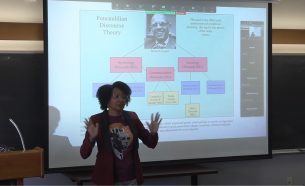
On Feb. 24, 2023, Journalism Assistant Professor Rachel Grant discussed the exploration of identity and culture within media platforms, and her work as research director for the Narrative Justice Project.
Read more
The proliferation of unchecked journalism and false reporting has led to adopting AI tools to wade through the mess. This begs the question, do online users trust AI to weed out fake news?
Read more
A team of UF scholars sought to examine what makes disinformation ads on social media appealing to users. The study looked at Facebook ads created by Russia’s Internet Research Agency in its Active Measures disinformation campaign targeting the 2016 U.S. presidential election.
Read more
Organizations are adopting live-chat systems that employ either human agents or AI-driven conversational agents. How consumers perceive these live-chat conversations is important in understanding how organizations build strong relationships with them.
Read more
The hesitancy to vaccinate children against COVID-19 has become a global public health threat. Research shows that people who are unvaccinated primarily get vaccine information from the internet, friends, and family, while those who are fully vaccinated primarily get information from their own physicians and from national health experts.
Read more
Past research has suggested that the way conservative media frames and communicates messages is distinct from both liberal partisan outlets and mainstream, non-partisan media. But current research suggests that conservative and liberal messaging approaches are not that different.
Read more
Many brands incorporate social issues into their social media campaigns and use AI to analyze consumer responses. This research looks at which type of algorithms are most effective in analyzing consumer sentiment.
Read more
Recent decisions by the U.S. Supreme Court such as the overturning of Roe. vs Wade have raised questions about the institution’s legitimacy in the eyes of the American public. A new study looks at whether the Roe decision has affected trust in the Supreme Court.
Read more
Why are so many women exiting the industry as a whole, even as a greater number of women are earning advertising-oriented degrees? New research attempts to address that by focusing more specifically on gender identity in the workplace and how it shapes women’s experiences across advertising agency departments.
Read more
Contemporary Disney movies act as a primary source of family role portrayals. By watching Disney movies like “Encanto” together, families can observationally learn how to navigate roles within their own families.
Read more
Artificial intelligence is projected to reshape the global economy. Automation technology is already permeating a broad spectrum of industries worldwide. One area of inquiry that has been given less attention is assessing how the presentation of AI in the workforce affects people’s perceptions about the technology.
Read more
Most consumers today are confronted with algorithmic-based recommendations based on their past usage or buying history. But how do consumers actually feel about machines recommending media or goods they might like?
Read more
Algorithms suffer from inherent bias due to human imagination, or lack thereof. Associate Professor Jasmine McNealy explains that it’s critical to mitigate the potential harm human intervention can have on developing algorithms by asking essential questions.
Read more
Interacting with members of other groups can promote understanding and reduce prejudice under the right conditions, but intergroup contact with refugees can be difficult to foster and maintain. Researchers wanted to investigate whether intergroup contact with a “virtual refugee” can effectively reduce this divide and foster closeness and empathy toward refugees.
Read more
In response to the extensive impact of the COVID-19 pandemic, collaborative efforts from multi-sector organizations emerged to help communities cope during these challenging times. Researchers s wanted to better understand how organizations from both the public and private sectors communicated these social partnerships on social media.
Read more
Janet Coats, Consortium on Trust in Media and Technology managing director, discusses the importance of media literacy and its impact on free expression and civil discourse.
Read more
Clay Calvert, Brechner Eminent Scholar in Mass Communication and Director of the Marion B. Brechner First Amendment Project, discusses key issues and common misperceptions about the First Amendment, the impact of a more conservative Supreme Court, and student free speech protections.
Read more
Artificial Intelligence is now being used to help tutor students at all educational levels. This research explores whether or not AI tutors are as effective as human tutors, specifically in language and writing education.
Read more
The field of human-machine communication has grown exponentially over the past 10 years with the advancement of new artificial intelligence technology. Research on HMC has also exploded focusing on both the technology itself and the implications for users and society.
Read more

Why did Trump supporters and others buy into the “Big Lie” about the 2020 election results? New research shows that election fraud fact-checking may correct viewers beliefs but does not necessarily change partisan attitudes toward the Capitol Hill attack.
Read more
While most Russians approve of the country’s invasion of Ukraine, an examination showed that people who had access to media sources other than those run by the Russian government were more likely to oppose the war in Ukraine.
Read more
To manage the adverse effects of unemployment and maintain one’s well-being, unemployed workers often develop coping strategies, such as playing video games. Researchers wanted to better understand how unemployed workers used video games to cope with the stress from unemployment specifically during COVID-19.
Read more
As more uses for technology emerge, researchers are interested in studying which mechanism of technology, such as chatbots, voice assistants, and social robots, are most effective in explaining social presence and perceived trustworthiness for users. In other words, how do people tend to interact with different forms of interactive technology?
Read more
Data collection is a known inevitability when it comes to using the internet. While data tracking is common knowledge, how the data is collected and used is not widely known or understood.
Read more
In this study, scholars used Twitter data to examine how political elites from both political parties communicated norms to their constituents about mask-wearing during the pandemic.
Read more
During the early stages of the pandemic, secure messaging became a critical mode of communication for healthcare providers and their patients, addressing, in particular, misinformation about COVID-19.
Read more
Stay-at-home dads are more common than ever before. Because of fathers’ changing roles in the household, advertisers are shifting how they market their products to this target audience.
Read more
Marketers are increasingly taking advantage of AI strategies when interacting with prospective customers, particularly in data collection and message targeting. But how consumers perceive or understand the use of AI in marketing has been unclear.
Read more
Ads claiming products are environmentally friendly often include complex claims that are confusing to even knowledgeable consumers, resulting in “greenwashing” — misleading information about the environmental practices of a company or the environmental attributes and benefits of a product or service.
Read more
This new study explores the power of words as they are used with and for technology, attempting to define frames of ethics and the complexity involved when it comes to describing and communicating ethical uses of technology.
Read more
As artificial intelligence technology has advanced, its use has expanded to a range of industries, including broadcast news. AI could be used in place of a human weather newscaster, for example, if a human is not available during a weather emergency. Yet little research exists that looks at how people perceive AI newscasters.
Read more
In our polarized political environment, scientific knowledge alone is not always enough to inspire change or action. When it comes to environmental topics in particular, imparting such information without a careful strategy can often have the opposite effect of the desired behavior.
Read more
Sports journalism has evolved from simply including play-by-play and color commentary during a live game to incorporating more audio and visual storytelling elements. As a result, the education provided to sports journalism students should reflect these changes.
Read more
The use of smart speakers, such as Alexa and Google Assistant, has become ubiquitous in American society. UFCJC researchers wanted to better understand the different ways people use the devices, as well as identify the main strategies they use to protect their privacy during that use.
Read more
One of the very few unifying propositions across all U.S. ideologies is that young people need more effective civics education. Given that widespread consensus, it might be expected that educators and policymakers would be tightly embracing the curative of scholastic journalism. But that is rarely the case.
Read more
The demand for sustainable products and services is growing steadily. New research explores the topic of sustainability in media and communications from the perspective of the top three areas of concern according to the United Nations: ecological sustainability, economic sustainability, and social sustainability.
Read more
Journalism Assistant Professor Rachel Grant is Research Director for the Narrative Justice Project, a tactical response to popular media conversations around stereotypes and conversations around racism. We interviewed Dr. Grant on Nov. 3, 2021 about the project and findings from the research so far.
Read more
The primary function of “social robots” is to facilitate communication with humans, and is being applied in a variety of industries, including education and physical and mental health. Dr. Kun Xu is studying how to enhance that communication through voice, gestures and other social cues.
Read more
Women shopping for plus-size clothing face many challenges, and are often isolated through marketing, language and website navigation. Researchers found that clothing retailers have a long way to go to incorporate inclusiveness into their women’s plus-size shopping experience, especially online.
Read more
University of Florida College of Journalism and Communications Advertising Visiting Lecturer Santiago Kember shares insights on how the Hispanic and Latino markets have changed over the past decade and what advertisers need to do to reach this market going forward.
Read more
Doctoral student Fanjue Liu is exploring how AI-enabled virtual assistants, like Alexa or Siri, can mitigate feelings of loneliness and isolation, particularly during the pandemic.
Read more
A woman’s willingness to initiate sexual health conversations with their doctors can make a difference in the quality of care she receives. This research explores whether a woman’s age had any effect on her willingness to take the lead for her own sexual health care.
Read more
Doctoral student Yoo Jin Chung discusses her research on AI-enabled virtual influencers on social media, and how social media users react to virtual vs. human influencers.
Read more
Sports networks have adopted the “Madden” camera to provide a more dynamic view of the football field of play. But do these new angles make it more difficult for viewers to estimate yardage than traditional play-by-play cameras?
Read more
Levels of political polarization continue to escalate in the U.S., causing an increasingly wide chasm between liberals and conservatives. New research explores whether liberal and conservative news outlets contributed to this political divide and increased polarization.
Read more
Research has found that behavioral lifestyle interventions for adolescent obesity treatment is critical to the success of any program hoping to make a difference in the lives of obese or overweight teens. A new study shows that adolescents affected by obesity believe interventions should avoid focusing on weight loss and instead promote a healthy lifestyle.
Read more
Communicating effectively with vaccine-hesitant patients is critically important to increase the number of vaccinated individuals in all countries. Research on communicating with vaccine-hesitant patients has demonstrated that good communication can make a difference in patients’ vaccine choices.
Read more
Dark patterns are design elements that deliberately obscure, mislead, coerce and/or deceive website visitors into making unintended and possibly harmful choices. They take the form of deceptively labeled buttons, choices that are difficult to undo and graphical elements like color and shading that direct users’ attention to or away from certain options.
Read more
Female empowerment advertising, or femvertising, has been a popular trend for brands advertising to women since Dove’s Campaign for Real Beauty in 2004. But new research considers ways that these seemingly positive advertisements can be harmful to feminist agendas.
Read more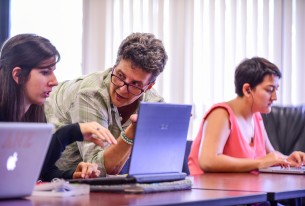
A time comes for many journalists when they think about teaching. This article will cover salary, education requirements, and workload. At the end, you’ll find a list of common terms used in academic job ads and a few links to academic job listings in journalism and communication.
Read more
As the emergence of digital technologies has transformed the news industry, the way that journalism is taught has changed as well. Researchers wanted to explore what legal and ethical principles and issues affect educators, and which most commonly arise when educators serve as de facto publishers.
Read more
Why do we focus more on the bad than the good? Why do we seek out the more traumatic vs. feel good news stories? Researchers wanted to learn more about the factors that could affect one’s inclination to veer toward negative or positive information, including age, political uses and approaches, and the type of exposure to news.
Read more
The assistant professor in emerging media discusses how users interact with robots, what types of cues and gestures are most effective in human-machine communication, and the convergence of various communication technologies.
Read more
When a fictional female journalist appears on screen, chances are she’s about to sleep with one of her sources. It’s a trope that infuriates actual women in news media — and it can have real-life consequences, says University of Florida researcher Frank Waddell, Ph.D.
Read more
As brands increasingly acknowledge social issues in their advertising, researchers wanted to know how use of social media affects consumers’ responses to a social media-based advertising campaign designed to incorporate the concept of a woke mindset.
Read more
Society needs to be very careful about the deployment of artificial intelligence systems and needs to answer who is the solution best for, who is affected and what are the potential impacts.
Read more
Vaping has skyrocketed over the past several years, particularly among 18–24-year-olds, and the effects can be negative. Social media has become a major channel for promoting vaping, and new research examines the characteristics of these promotional social media posts.
Read more
Health care issues in the U.S. continue to increase, while trust in journalism continues to decrease. Despite these challenges, there is a unique opportunity for journalists to not only take back credibility and audience trust, but to impact overall public understanding of health policy and issues.
Read more
The growing technological sophistication of smartphones has transformed them from merely communication devices to essential companions that we interact with throughout the day. This research examines the effects of two social dimensions of smartphones — language and modality — on social responses to these devices.
Read more
Fake news is on the rise. And it can be profitable. More than 100 fake news websites existed during the 2016 U.S. presidential election, with many sites making $2,500 or more a day from advertising sponsorship. But what is the risk for brands who, intentionally or unknowingly, sponsor content on those sites?
Read more
Despite the urgency to modernize the nation’s power grid, there has been some public resistance to installing smart meters on people’s homes. Like any topic, misinformation has spread through the public resulting in false perceptions about health, privacy and costs.
Read more
Controversy over legislative bill names is hardly new. Politicians have long used bill titles as a marketing vehicles to get media attention, drum up support and frame the conversation around the bill before their opponents do.
Read more
On March 30, 2021, Telecommunication Professor and Director of Media Consumer Research Sylvia Chan-Olmsted discussed new research from her and Advertising Associate Professor Huan Chen, “Fairness in Information Access Through Culturally Competent AI Systems,” at the spring 2021 University of Florida HiPerGator Symposium.
Read more
While social media influencers tend to be related more to brand evangelism or financial exchange, Kamala Harris’ use of Twitter throughout the 2020 presidential campaign led to her current position as a social, cultural, and political influencer.
Read more
President Joe Biden is considering a variety of tax options to pay for his $3 trillion infrastructure and jobs package. How will he sell a new tax? Reframing taxes as an investment in public services that we all use or benefit from—such as roads and bridges, water and sewer systems—would be one approach.
Read more
To understand the emergence of podcasts as an information and entertainment medium, UFCJC researchers completed the nation’s first comprehensive study on motivations and consumption of podcasts, as well as the interaction between podcasts and other audio media.
Read more
In the fight against vaccine skepticism, employers can play a key role, not only because it’s an important precaution for the health and safety of their employees, but also because a recent survey shows people around the world tend to trust their employers more than governments or the media.
Read more
UF researchers and colleagues, led by the UF STEM Translational Communication Center, are exploring new approaches to communicating health interventions to patients, including use of an internet-based virtual humans that patients can access through an app.
Read more
Dr. Carla Fisher discusses her research on effective mother-daughter and family communication about breast cancer and other chronic diseases, and how clinicians can play a role in fostering that communication.
Read more
Secure messaging, online communication between patients and clinicians within the electronic health record, soared almost 50% from pre-COVID-19 to the present. This research explored how to communicate effectively as telemedicine becomes standard.
Read more
Effective communication between healthcare workers and patients is critical to shaping risk-reducing practices and coping with rigorous treatment for life-threatening diseases. But communication between family members can be as important in dealing with medical issues.
Read more
CJC scholars and Centers explore misinformation and vaccine hesitancy, how AI-base recommendation engines can reinforce vaccine misinformation, and strategies to increase the publics’ confidence in COVID-19 vaccines.
Read more
Is the new audio-based, invitation-only Clubhouse social app a return to the past? Telecommunication Assistant Professor Kun Xu looks at how Clubhouse departs from current social media platforms.
Read more
CJC researchers address AI’s negative impact on communities of color and how AI can be used to more effectively disseminate culturally relevant information to different audiences.
Read more
Undocumented immigrants that are part of the LGBTQ community, also known as Undocuqueer, historically has been underrepresented in positive text and visualizations: narratives that aid social and political opinion, help to reduce negative stereotypes and provide awareness and movement toward equal rights, respect and love.
Read more
America has a rich history of peaceful protests and demonstrations on public property to exercise their First Amendment right of freedom of speech, regardless of how vitriolic or partisan that rhetoric may be. But the Supreme Court will soon have to weigh in on the constitutionality of the issue because of more advanced communication tools.
Read more
The destructive spread of misinformation and continued attacks on news media credibility has fostered a crisis in trust. To address this, the University in 2019 committed $1.25 million to launch the Consortium on Trust in Media and Technology as one of its eight “moonshot” initiatives.
Read more
With breast cancer as the most commonly diagnosed cancer for women in the U.S. and the leading cause of death for women in the world, it is critical for mothers and daughters to discuss the disease, potential causes and how to reduce risks of developing breast cancer.
Read more
Dr. Jieun Shin discusses her research on algorithms, AI and the spread of misinformation.
Read more
As partisan news networks like Fox News and MSNBC have risen in popularity, so has the polarization of many Americans’ political views. New research finds that while both liberal and conservative media contribute to polarization, conservatives are more likely to be part of a media echo chamber, trusting fewer sources and seeking information from a narrower range of news outlets.
Read more
The global COVID-19 pandemic has caused anxiety and stress in most people, but college students specifically have had to learn to cope with uncertainty and upheaval from their normal routine. Researchers found that the more anxiety a student experiences, generally, the more media they consume to combat their weariness.
Read more
Claims of fake news has infiltrated the national consciousness and rhetoric. The widespread use of the term have caused a distrust with American media. This study explored how an individual’s news sources and consumption may affect their perceived ability to differentiate what news is real and what news is fake.
Read more
Dr. Juliana Fernandes discusses the impact of negative and other persuasive communication has on voters’ perspectives.
Read more
Despite the promise of new COVID-19 vaccines on the horizon, no vaccine will be effective if people refuse to take it. A team of scholars, strategists and storytellers from organizations around the world were asked to identify research-based messages that might overcome vaccine hesitancy.
Read more
CJC researchers identified three types of sexual and reproductive health communication barriers reported by parents and/or children internationally: personal, communal, and cultural.
Read more
CJC doctoral candidate Amanda Bradshaw was interviewed on Oct. 20, 2020 about her research on vaccination hesitancy and misinformation.
Read more
Dr. Clay Calvert discusses First Amendment issues, including protections for hate speech, misinformation, judicial activism, and a more conservative Supreme Court.
Read more
Traditional TV and on-demand viewing are often seen as either lean back or lean forward media with different advertising implications. Recent research suggests that rather than treating these two video platforms as either passive or active, marketers should focus on why and how consumers use TV versus online videos through the lens of immersion and engagement.
Read more
Researchers examine three groups — creatives, noncreatives and the general population — to determine if there are significant differences in creativity between creative and non-creative individuals.
Read more
Change, particularly organizational change, can be difficult for many people. By supporting change through positive leadership communication practices, employees are more apt to be open to supporting that change. This brings with it a wealth of potential for positive and productive business practices.
Read more
Can star ratings for political content on platforms like Amazon alter our feelings towards others with similar or opposing political preferences? When we see ratings that disagree with our own, are we more likely to believe the ratings are manipulated? New research indicates that exposure to counter-attitudinal ratings contribute to polarization.
Read more
Myiah Hutchens, Public Relations Department assistant professor, was interviewed on Sept. 22, 2020 about her research on political communication and trust in news.
Read more
Despite efforts to improve colorectal cancer (CRC) screening with a goal of reducing mortality and health outcome disparities, CRC is the third-leading cause of cancer deaths among Black women in the U.S. Researchers explored the use of a virtual health assistant to promote CRC screening among Black women.
Read more
Corporate executives have increasingly been engaging in CEO activism since Donald Trump was elected. A recent study explored who is more likely to influence the media’s agenda, the president or the CEOs, when both throw their weight behind a position on the issues of social and political importance?
Read more
Wearable devices such as smartwatches could play an increasingly important role in healthcare. But providers have given wearable devices mixed reviews: while some laud their contribution to patient care, others are more skeptical of their accuracy and efficacy.
Read more
In the U.S., people have become polarized around a number of issues based on a variety of potential dividing lines including where they live, their age, their political beliefs, and their race/ethnicity. One pressing issue where different ideological groups believe in different things is climate change.
Read more
Have you recently had a conversation with someone about wearing a mask to stop the spread of COVID-19? New research suggests that this discussion may have driven your conversation partners into a media echo chamber in which they seek out news that confirms their beliefs.
Read more
There has never been a time when America more urgently needed to hear the voices of college athletes. Yet for athletes at many of the nation’s top athletic programs, talking to the news media is regarded as a punishable offense.
Read more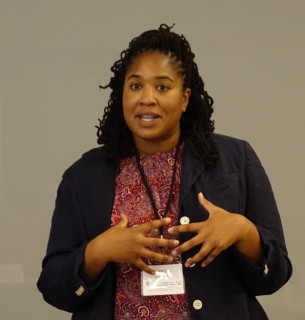
In this video interview, Telecommunication Associate Professor Jasmine McNealy discusses her research on data trusts, equitable AI, communicating AI and how technology is amplifying “otherness.”
Read more
The global pandemic has disrupted all facets of society, with one of the most notable being professional and collegiate sports. While some live sports broadcast productions had slowly been moving toward a more remote model to cut costs for years before the pandemic, University of Florida College of Journalism and Communications researchers suggest COVID-19 will speed up this trend.
Read more
In this video, Journalism Assistant Professor and Trust Scholar Frank Waddell discusses his research on technology’s effect on trust in news and increasing bias against and harassment of female journalists.
Read more
Minority populations, particularly Black men, have a greater incidence, prevalence, and mortality rate from prostate cancer than other groups. Because of this, communicating pertinent medical information and disseminating materials specific to Black men is critical to combat this trend.
Read more
Young adults are navigating physical, cognitive, and psychological changes, and transitioning into a more independent time of their life including social life and making more decisions on their own. They often grapple with unique issues when faced with a cancer diagnosis.
Read more
Advertisers are increasingly turning to video ad customization to engage consumers in their products. However, beyond simple recall, do customized embedded video ads really enhance advertising effectiveness while also minimizing the potentially negative effects caused by perceptions of intrusiveness?
Read more
Many technology companies use algorithms to determine what content should be presented to users based on their previous behavior and preferences. But the technology can create a dangerous feedback loop of reinforcing misinformation: the more you click on a subject, the more recommendations for that subject occur, thus creating the illusion that the more you see something, the more it must be true.
Read more
Breast cancer is the most common cancer among women in the United States. It’s also the leading cause of death for women globally. But educational information that doesn’t take into account cultural differences among women may not be as effective as communication embracing those differences.
Read more
Organizational culture is a social glue that holds organizational members together and prescribes how things are understood, judged, and valued in an organization. What can leaders do to promote the positive emotional culture of the workplace? How can internal communications cultivate a positive emotional culture and facilitate employees’ sense of belonging in their organizations?
Read more
Emerging information technology is amplifying otherness through neglect, exclusion, and disinformation, all of which have significant consequences. Neglect, while perhaps the most recognized problem with emerging technology, is persistent.
Read more
Instagram continues to be one of the fastest growing social networks and currently has more than one billion users. While Instagram has not been a focus of investigations into misinformation, it has not been immune to bad actors. And the nature of the Instagram platform, for example the inability to link to credible sources, makes establishing authenticity problematic.
Read more

The news media often frames information using words that can elicit emotions to attract audience attention and promote certain actions. Emotional frames are especially prevalent on issues that involve morality, such as news regarding sexual harassment and sexual assault.
Read more
As election season continues, scholars want to know what communication behaviors look like during a campaign cycle. Do communication behaviors increase? Do events like debates and polls affect an individual’s quest for information? Does it matter where voters live, for example in a battleground state?
Read more
A 2018 Chinese policy bans most U.S. imported solid waste. As a result, what was once recyclable may no longer be. How does a local government effectively communicate these process changes when recycling habits are ingrained in daily routines?
Read more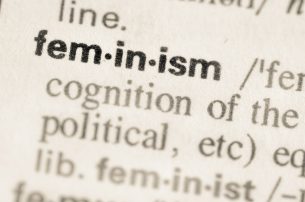
Pro-female advertisements, or femvertisements, receive praise for empowering women. But is that the message that’s actually received?
Read more
Brands often use social issue advertising to evoke emotion in their media campaigns. This type of advertising, however, could elicit emotional responses beyond what the advertiser intended.
Read more
The global pandemic has forced colleges and universities online. This article describes strategies necessary for success.
Read more
The use of data has become a vital investigative tool for journalists. But many journalism programs and courses worldwide are insufficient or unable to provide students with the essential skills needed to gather, analyze and present data.
Read more
America’s CEOs have important leadership roles to play as the crisis poses a test of their ability to help their workers not only endure and stay healthy but keep them motivated and engaged as well.
Read more
The practice of journalism faces a myriad of challenges, including a continual stream of complaints about the credibility of today’s news. The advent of “fake news” has tarnished the longstanding trust and transparency considered the foundation of journalism.
Read more
Research has shown that primary care providers (PCPs) play a critical role in influencing whether cancer patients choose to participate in cancer clinical trials. Yet only a small number of surveyed PCPs reported discussing the possibility of participation in clinical trials with their patients.
Read more
A team of researchers at the University of Florida studies the content, sources and messaging around the 2017 documentary series, Vaccines Revealed.
Read more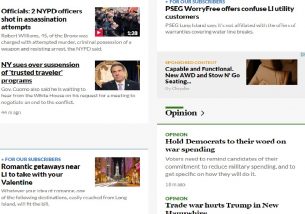
Native advertising online – advertisements that look like editorial content – has grown dramatically as a source of revenue for media companies. This study evaluated whether consumers recognize native ads on digital news website home pages at the same speed and as effectively as they do banner advertising.
Read more
While media is often blamed for exacerbating the ideological and political gap between political parties, discussing politics among friends and family also has a significant impact on increasing polarization, particularly when individuals of opposing political affiliations are not participating in open dialogue.
Read more
People use cues every day to communicate. But how are these cues — relative to Siri, Alexa, social robots, or the myriad hybrid computer and artificial intelligence technologies — being developed?
Read more
As private universities expand their policing jurisdiction into surrounding residential areas, questions arise over how non-governmental actors can be given the authority to exercise the power to use deadly force and to take away freedom without governmental accountability.
Read more
CJC researchers created a cancer clinical trial information website and conducted a study to determine if the site would increase trial comprehension and, ultimately, participation in cancer trials.
Read more
Black spending power is increasing rapidly. This study examines how mainstream brands are creating products, messaging, and distinctive campaigns for targeted ethnic audiences.
Read more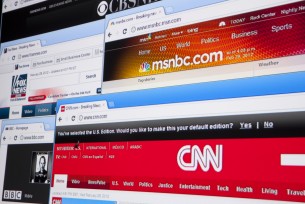
Research shows that people tend to choose media outlets that validate their perspective on climate change. But does viewing climate change content on liberal, non-partisan or conservative media outlets change their behavior?
Read more
AI is increasingly being used by media companies to drive engagement and improve operations. But the complexity of producing appealing content based on both creativity and data, and integrating AI into the existing media ecosystems, might be challenging.
Read more
It is critical for a company to be recognized by their brand as well as to be known for supporting positive corporate responsibility through community initiatives. But will attaching themselves to one side of the debate on a controversial issue impact that brand image?
Read more
Family medicine physicians have begun to integrate acupuncture into their conventional treatments. One way to help physicians communicate information and understanding about acupuncture and its benefits is through the use of metaphor.
Read more
Although gagging public employees from giving unapproved interviews is pervasive across all levels of government, blanket restrictions on speaking to the media are legally unenforceable.
Read more
Research has shown that political satire could play a role in informing people about political issues and lead to people increasing their use of hard news. But is that really the case?
Read more
Existing research indicates that professional law enforcement officers are generally no better than untrained novices at detecting deception. But digital games could help improve officers’ ability to detect deception.
Read more
As ever-advancing digital technology spews more and more data about consumers, some industries are struggling with how to effectively collect, sort, interpret, and use big data. The advertising industry, in particular, recognizes the data gold mine, but faces challenges in how to effectively use that data to benefit clients and consumers.
Read more
There are now more than 450 electronic cigarette (e-cig) brands on the market and the U.S. Food and Drug Administration (FDA) has declared that the use of e-cigs – or vaping – among young adults has reached “an epidemic proportion.” Recently, there have been several deaths associated with vaping.
Read more
Broadcast radio continues to come under increasing pressure with the emergence of new platforms for audio media discovery and listening. Many have launched their own digital apps. But is that enough?
Read more
News organizations that publicly investigate their reportage may face unintended consequences if the they’re taken to court.
Read more
In a day and age where robots and artificial intelligence are a reality, the question of how different humans interact with these machines is key to improving the experience and outcomes.
Read more
The impact of stress on medical residents continues to be a major concern in the medical community, given that the well-being of practitioners is critical for the quality and safety of patient care. A new study suggests that stress management training could help.
Read more
It has become increasingly difficult to decipher fact from fiction on social media sites. As a result, warning labels are appearing online in the hopes of curbing the dissemination of less-than-credible news reports.
Read more
Popular opinion in some academic circles has been that “big ownership” is bad for diversity. But does ownership structure or type really play a role in the diversity levels of on-air talent in local markets?
Read more
Digital gaming by older adults could lead to more social connectdness, social capital and civic participation, according to a recent study.
Read more
Academic research on virtual reality is also common, but what insights can be gleaned from this large body of work? A new study identifies issues with previous research on VR.
Read more
Research explores how to better recruit COPD patients, particularly from marginalized populations, for research studies.
Read more
The continued shift from traditional media to digital promotion has forced advertising agencies to rethink how they best capitalize on technology platforms and the organizational structure to support it.
Read more
Advocacy campaigns aimed at thwarting teen dating violence are often focused on how females can avoid becoming a victim. But ads targeting teen boys that mirror appropriate behavior can also be beneficial.
Read more
Mobile health technology affords patients the opportunity to get the medical expertise they need without a physical visit to a practitioner’s office or a run to the emergency room. But, for it to be truly worthwhile, the technology must be accessible to patients and simple enough to navigate.
Read more
As with any private organization, institutions of higher education are susceptible to controversial scenarios requiring evolving crisis communications plans and strategies. One increasingly critical element in crisis communications is the optimization of multi-platform communication channels, particularly social media.
Read more
The study explores the influencers of sports consumption on smartphones from the perspectives of motivations, fandom, and media types.
Read more
The way employees feel in the organization affects their attitudes toward/relationship with the organization. Does emotional culture affect employee behaviors in the same manner? If so, what should communication leaders do?
Read more
The popularity and availability of VR videos is rapidly increasing, with more than one million subscribers to YouTube’s VR channels. While marketers have experimented with product placement in VR videos, little is known empirically if it is an effective strategy for brands.
Read more
By some estimates, fantasy sports is a $7 billion business in North America alone, with nearly 60 million adults participating in one or more fantasy sports. But are marketers optimizing their ability to reach this lucrative market at the right time and in the right place?
Read more
Instagram users prefer sponsored ads that mimic posts from their friends over traditional advertising, although this type of advertising may seem sneaky or deceptive, new research shows.
Read more
Breast cancer is the most common cancer affecting women and the second leading cause of cancer-related deaths for women. Understandably, women often look for ways to decrease their chances of having breast cancer, not only for themselves, but also for their daughters. Unfortunately, that isn’t always a simple task.
Read more
Dr. Jeremy Yip, assistant professor of management at Georgetown University’s McDonough School of Business, won the 2019 Prize for Research in Public Interest Communications for his paper, “Losing Your Temper and Your Perspective: Anger Reduces Perspective-Taking.”
Read more
For years, spoilers have been the bane of entertainment media audiences everywhere. The word itself has become almost synonymous with ruined enjoyment. But, are spoilers really that bad?
Read more
Kendrick Lamar won a Pulitzer Prize last year and Eminem set a record in 2019 for streams on Spotify. But the acceptance and embrace of rap music in mainstream culture isn’t shared by everyone – and that sometimes includes the police.
Read more
In today’s fragmented media marketplace, branded content becomes a good approach for companies to engage with their audiences. Yet there appears to be little consensus on the concepts behind branded content or the practice and process of branded content itself. A team of UFCJC researchers decided to see if they could find some common ground among world experts.
Read more
Seven senior public relations executives visited CJC during the 2017-18 school year. We asked them about industry trends and preparing for a public relations career. Here’s what they told Us.
Read more

Family stories about mental illness shared from one generation to another can both reinforce stereotypes and yet still teach children important lessons and expectations about the management of such illnesses, according to a new pilot study.
Read more
News organizations are starting to experiment with automated content. Research suggests readers perceive news written by algorithms as less credible than if it’s written by a human. However, this perception can be reduced by exposure to robots in popular culture.
Read more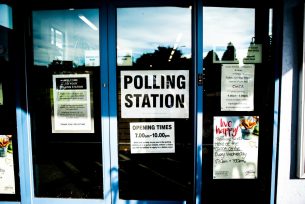
Many political researchers and commentators have presented different theories that attempt to explain Donald Trump’s appeal to the American voters who elected him president. A new analysis suggests that Trump supporters’ motivations included negative opinions about the economy in general and about the Black Lives Matter movement.
Read more
It’s increasingly challenging to combat fake news and to help people distinguish it from real news. CJC researchers examine fake news through the lens of the U.S. Supreme Court. They suggest that part of the answer to fake news lies in finding ways to make real news more appealing to general audiences and to earn readers’ trust in the stories.
Read more
Many health campaigns have sought to change drinking habits and prevent alcohol abuse. These campaigns often rely on fear-based or humor messages to convey the dangers of alcohol abuse. Researchers are now testing whether these emotions change people’s perceived risk or intent to drink, especially among college students.
Read more
People frequently make decisions based on irrelevant information due to unconscious cognitive biases. How can people avoid relying on cognitive shortcuts that leave them vulnerable to making poor choices? New research suggests they might want to play a game coupled with an informative slideshow.
Read more
When students walked out of school to protest what they see as lax gun laws, some risked punishment from their schools. But it may be worth it to send a First Amendment message.
Read more
Attitudes of primary care physicians play a key role in a recently diagnosed cancer patient’s access to and beliefs about clinical trial treatments. Acting as opinion ambassadors, they have the power to influence their patients’ attitudes and behaviors.
Read more
Faced with dwindling resources, and a news cycle that never sleeps, today’s health journalists must meet a new challenge: provide complete, trustworthy content on health care issues with precision at the same breakneck speed with which the medical field innovates.
Read more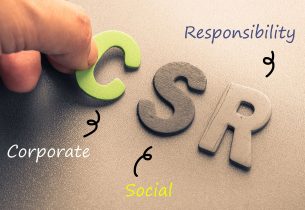
Companies can have a variety of reasons for engaging in what the public considers socially responsible (CSR) practices. How do they maintain their reputation and sense of alturisim in a crisis? Research suggests they should have a proactive strategy.
Read more
More and more companies today are striving to develop an emotional culture which emphasizes how employees feel. Does emotional culture truly matter for an organization’s success?
Read more
Seeing violence in media that sanitize, justify or trivialize violent acts may normalize it and make it more enjoyable. Frank Waddell, assistant professor of Journalism, worked with a team of researchers to examine techniques for reducing the effects of viewing violence in media.
Read more
News organizations, in pursuing their role as watchdogs, have at times revealed an individual’s personal information in their stories, known as “doxxing.” Jasmine McNealy, assistant professor of Telecommunication, examines the reaction of the online users to doxxing by media organizations in this case study.
Read more
The result of good doctor-patient communication is clear – patients make more informed decisions, have better quality of life, and have lower incidences of anxiety.
Read more
Advertising Assistant Professor Carla Fisher is on a quest to help mothers and daughters better communicate about breast cancer and its risks, as well as integrate communication science into clinical practice.
Read more
STEM Translational Communication Center researchers examine the most effective ways to communicate about colorectal cancer risks.
Read more
To win the fight against cancer, UF STEM Translational Communication Center researchers are exploring how we communicate about cancer—both with each other and with the wider community.
Read more
It’s no revelation that social media have changed the way we learn and communicate new information. But is it an effective way to communicate health risks associated with cancer? STEM Translational Communication Center researchers investigate.
Read more
When the government attempts to restrict journalists, there are superheroes behind the scenes protecting journalists’ right to access information and share it with the public. Charles Tobin, B.S. Journalism 1984, is one of them.
Read more
In an age when smartphones and social media networks are ubiquitous, where some commercial enterprises abuse their access with potential consumers, is spam protected as free speech?
Read more
What happens when a controversial person requests to speak on the University of Florida campus? The First Amendment takes center stage, balanced against public safety concerns.
Read more
To be competitive in today’s information environment, companies must learn to not only trust audience data, but leverage it to better serve audiences and bottom lines.
Read more
Audience analytics is about knowing how to interpret, and even ignore, the data at hand and instead understand how the audience and your goals can converge.
Read more
In North Florida, few local media outlets ask their audience: What do you wonder? What should we investigate? We are. Our Innovation News Center is experimenting with audience-powered journalism.
Read more
To understand why fake news stories are successful, we must understand our human tendency to believe what we read, but that doesn’t mean our natural instincts can’t be reversed.
Read more
Why do people fall for fake news and share false contents? There is no single answer. But, Paul Mena, former BBC reporter and CJC graduate student, is currently looking for answers.
Read more
What should strategic communication in the public and social change sectors look like in a time marked by extreme political polarization and false information? Science suggests the key may be playing offense, rather than defense.
Read more
President Trump often objects to what people say about him on Twitter. As a result, he sometimes blocks their access to his account. The novel question arises: Is that unconstitutional?
Read more
Fake news is nothing new. Rich Shumate, media historian and CJC Ph.D. candidate, takes us through a piece of its history.
Read more
The federal government recently established a department tasked with identifying truth. Do the American people really need the government to establish truth from untruth?
Read more
People can’t differentiate between paid advertising and editorial content. Here are five ways to increase media literacy.
Read more
Funny health campaign videos are only as effective as their social media platform and associated comments.
Read more
For health organizations seeking to reach audiences through Facebook, how posts are worded has an impact on who engages with them.
Read more
To protect the integrity of the news as a source of information for the public, editors should adopt a “balance of interest” policy.
Read more
An interview with Public Relations Assistant Professor Rita Men on the benefits of CEOs using social media to connect with employees.
Read more
Showing empathy is critical for medical practitioners who often have to discuss sensitive medical information with patients. How providers talk to patients – demonstrating empathy– can lead to better health outcomes.
Read more
As the world becomes more divided, many are searching for ways to build understanding and cultural sensitivity. Virtual reality is a promising way to help people understand one another better.
Read more
Key questions about First Amendment speech rights senators should ask during the Senate Judiciary Committee hearings for United States Supreme Court Justice nominee Neil Gorsuch.
Read more
Many believe that they can spot fake news, while others out there surely will be duped. This is consistent with what research refers to as the third-person effect.

If someone sees or hears something they don’t want to believe…they probably won’t believe it.
Read more
An interview with Dr. Rita men on her new book, the power of using smart communication to reach internal stakeholders and why it is good for business.
Read more
How sports marketers should engage with today’s media consumers amid a multiplatform, fragmented environment.
Read more
Dr. Tom Kelleher, professor and chair of the Department of Advertising, talks with us about his new published textbook, the future of public relations and what he is working on next.
Read more
Government agencies charged with regulating digital technologies should do so under a standard that assumes most people don’t fully understand the technology.
Read more
Breast cancer patients who know what information to share and how or when to share it have better health outcomes than patients who hold back.
Read more
We talk with Journalism Professor Kim Walsh-Childers about her new book Mass Media and Health: Examining Media Impact on Individuals and the Health Environment.
Read more
As we look back at an historic election season, digging into the data to examine the public relations strategies of Donald Trump and Hillary Clinton leads to some surprising conclusions.
Read more
Understanding how audiences react to emotional messaging is critical, as it is a better predictor for understanding how people will behave and is a key factor in marketing.
Read more
Metaphors can help researchers communicate with patients about clinical trials. A patient’s ability to understand medical information, however, may influence which metaphor works best.
Read more
To grow and succeed in the dynamic and competitive global market, organizations must scan and monitor the environment constantly, make necessary adjustments and embrace change.
Read more
What drives people to take selfies? Advertising Professor Eunice Kim and her colleagues at Korea University conducted a series studies to better understand our selfie-taking tendencies.
Read more
People who obsessively play Facebook games like Farmville are often mocked for being anti-social. But, new research suggests that they play to connect with others.
Read more
Research shows how candidates and issues are having an impact on appeal, empowerment and engagement of voters.
Read more
Researchers have identified various variables to segment external audiences for better targeted communication. The discussion, however, is limited when it comes to internal audience.
Read more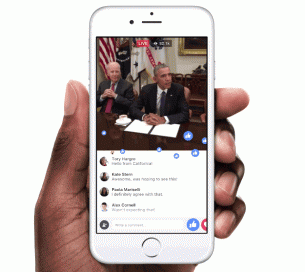
Everything you need to know if your are considering using live-streaming.
Read more
According to the science of selfies, they seem to tap into some deep psychological desires.
Read more
A new segment of people engage with the world wide web differently than others. Interactive audiences not only engage more with websites, but they are also more likely to share what they’ve done online with their friends.
Read more
When teachers in drug prevention programs tell better stories, students are more attentive to the lesson.
Read more
People engage with their favorite TV shows on social media if they feel a connection to the show and its characters and if they are technologically savvy.
Read more
To attract the attention of 20-somethings, customized, fun and interesting Twitter ads are the way to go.
Read more
Advertisers are branding consoles, accessories, in-game avatars and other aspects of the virtual world to reach new consumers, taking advantage of the growing popularity of video games.
Read more
To increase customer trust of your brand, use the right tone and language in your company blog posts.
Read more
The revelation that PayPal co-founder Peter Thiel financed the Hulk's lawsuit against Gawker raises important questions in the battle between privacy and a free press.
Read more
If you are fortunate enough to be able to hire data analysts, what does today’s ideal candidate look like? We asked some of the top consumer/audience research executives those questions.
Read more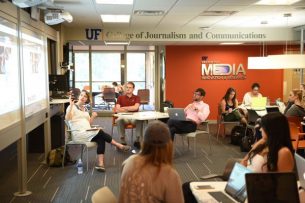
ACLS Public Fellow at the Center for Public Integrity talked with UF CJC students about building digital communities and the growing field of engagement analysis.
Read more
To increase brand recognition it’s important for gamers to see the same brand on the accessory in their hand as they do in the virtual world.
Read more
The perceived authority of physicians can lead people to be more susceptible to illness, as it leaves many patients reluctant to confront doctors on matters of hygiene.
Read more
CEOs who use social media to communicate with their employees are seen as better communicators, which leads to stronger relationships between companies and their employees.
Read more
Understanding the relationship between smartphone dependency and a consumer’s media consumption patterns and perceptions.
Read more
The U.S. Supreme Court has never answered this question. Here’s what the lower courts have said.
Read more
Understanding the battle between Amazon.com and The New York Times. Was it simply bad press?
Read more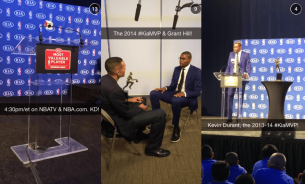
The NBA saw benefits of connecting with young fans on Snapchat in its early days.
Read more
The Supreme Court will soon decide if it will hear a case involving the off-campus speech rights of students.
Read more




